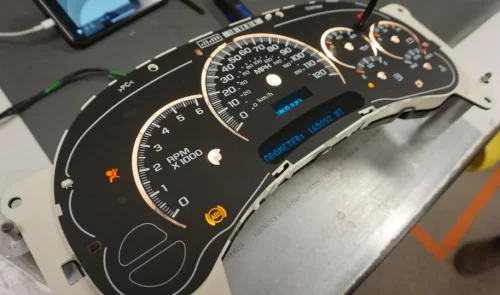The instrument cluster is an important part of any car; in fact, it’s often referred to as the driver’s information center. It’s the main source of information for the driver, providing instantaneous feedback on the vehicle’s performance, as well as vital indicators of other vital functions. As such, it’s important that the instrument cluster is in good working order so that you have accurate information at all times.
In this blog post, we’ll discuss what an instrument cluster is, how it functions, and the importance of a functioning instrument cluster. We’ll also look at how to diagnose common issues and how to fix them. Ultimately, the goal is to ensure that you have an accurate and reliable source of information throughout your journey. So, let’s get started!
Contents
1. Definition and purpose of an Instrument Cluster
The instrument cluster is the collection of gauges, dials, and indicator lights found in the driver’s line of sight in a car or truck. It provides an at-a-glance view of the vehicle’s vital signs, including speed, fuel level, engine temperature, and more. It is a vital tool that helps drivers stay aware of their vehicle’s condition and performance.
Additionally, the instrument cluster offers important safety features, such as alerting the driver to potential issues and allowing them to make quick decisions to avoid accidents. An instrument cluster is an essential component of any vehicle, allowing drivers to stay informed and safe while they’re on the road.
2. Components of an Instrument Cluster
An instrument cluster is an important component of any car, truck, or other vehicle. It contains a variety of gauges and displays that provide essential information to the driver. Generally, an instrument cluster consists of two main components: a set of gauges and a set of warning lights.
The gauges measure and display data such as speed, engine temperature, fuel level, and oil pressure. The warning lights usually indicate when something is wrong, such as low oil pressure, overheating, or low fuel level. A good instrument cluster can help the driver stay alert and informed, and it can also help prevent more serious problems from occurring.
3. Features of an Instrument Cluster
An instrument cluster is a panel full of gauges, dials, and lights that provide the driver with crucial information about the vehicle’s performance. It’s an essential component of any vehicle’s dashboard and is integral to the safe and efficient operation of the car. Here are three features of an instrument cluster that make it so important:
1. Speedometer: A speedometer is essential for the driver to maintain a safe speed, as well as for keeping track of how far and fast the vehicle has traveled.
2. Warning Lights: Warning lights alert the driver to potential mechanical problems and system malfunctions, so they can be addressed as soon as possible.
3. Fuel Gauge: The fuel gauge allows the driver to keep track of how much fuel has been used, so they know when they need to refuel.
4. Benefits of having an instrument cluster
The instrument cluster is an important component of any vehicle. It provides essential information about the speed and other performance parameters of the vehicle and helps the driver make informed decisions. Here are some of the benefits of having an instrument cluster:
 1. Improved safety – An instrument cluster provides the driver with important data that can help prevent accidents. For example, it can indicate low fuel, tire pressure, and other warning signals.
1. Improved safety – An instrument cluster provides the driver with important data that can help prevent accidents. For example, it can indicate low fuel, tire pressure, and other warning signals.
2. Increased convenience – All the necessary information is readily available in an instrument cluster, so the driver doesn’t need to search for it. This makes driving more convenient and efficient.
3. Improved driving experience – An instrument cluster can be customized with various gauges and indicators, allowing the driver to have a personalized driving experience.
4. Enhanced visibility – With an instrument cluster, the driver can easily see information such as speed and RPM. This makes it easier to monitor performance and adjust driving habits accordingly.
5. How to maintain an Instrument Cluster
An instrument cluster is an essential part of a vehicle’s dashboard, as it contains all the gauges and dials that provide information to the driver. Knowing how to maintain this important device is important to ensure its optimal performance. Here are five tips to help you maintain your instrument cluster:
1. Check the wiring – Make sure that all the wires connecting to the instrument cluster are secure and in good condition.
2. Clean the contacts – Dirt and debris can accumulate on the contacts of the cluster and affect its performance. Use a cotton swab dipped in rubbing alcohol to clean any dirt or debris.
3. Monitor the lighting – Ensure that the lighting in the instrument cluster is working properly. If any of the gauges or lights aren’t working properly, it’s important to have them checked and replaced if necessary.
4. Inspect regularly – Periodically inspect the cluster for any signs of damage or corrosion. If any problems are found, contact a mechanic to have them repaired.
5. Replace worn or damaged parts – If any of the parts of the cluster are worn or damaged, make sure to have them replaced by a professional to ensure optimal performance.
Conclusion
In conclusion, the instrument cluster is an essential component to the overall performance of a vehicle. It helps the driver monitor the vehicle’s vital functions and can help alert them to any potential problems. It is important for drivers to be familiar with their vehicle’s instrument cluster, as well as how to read and interpret the information it displays. By understanding how the instrument cluster works and what it displays, drivers can better ensure their safety and of those around them.




